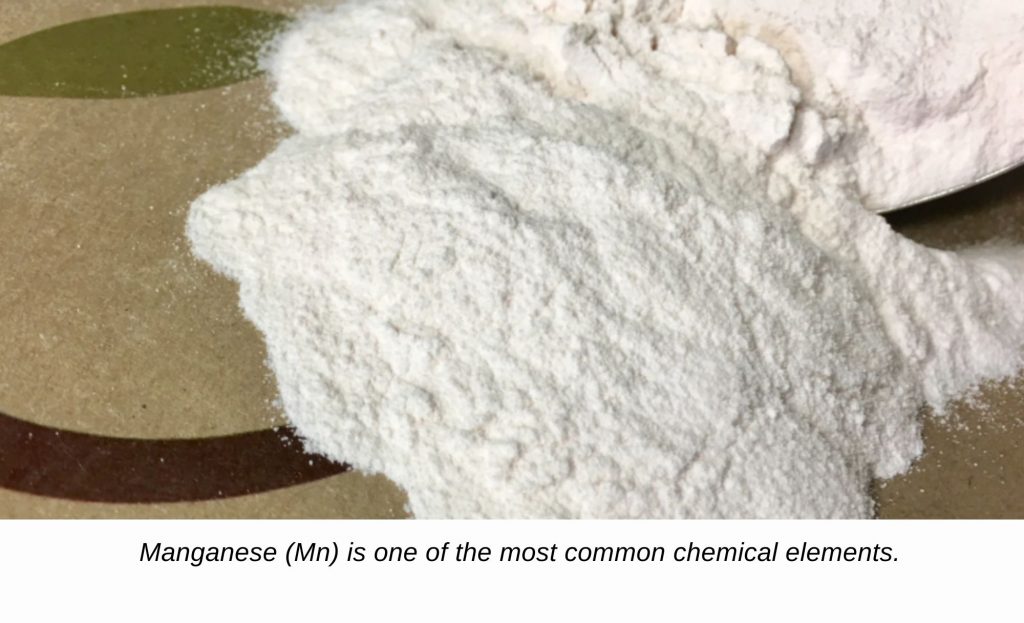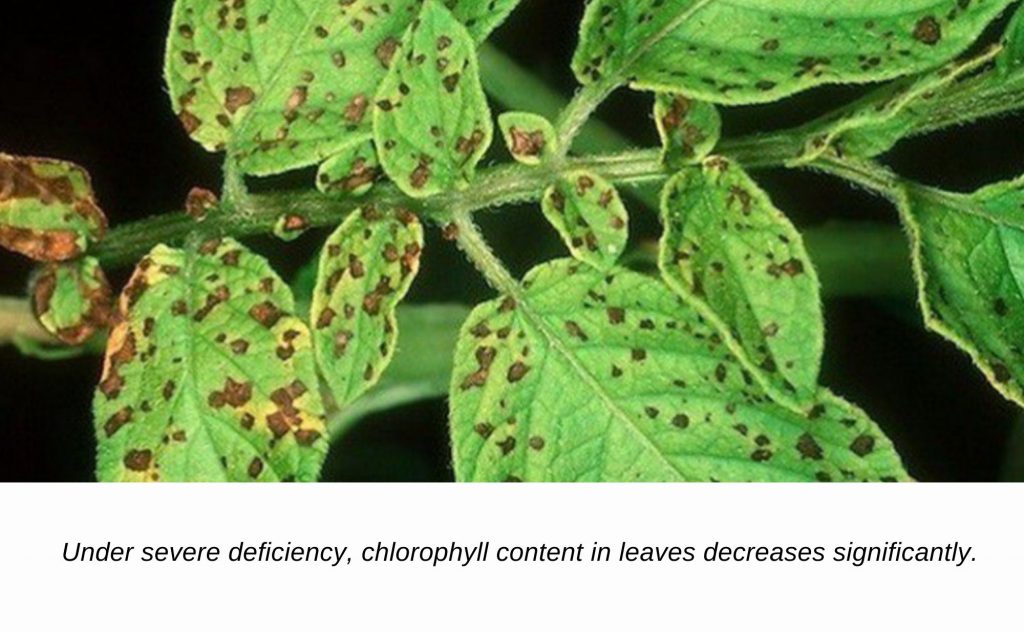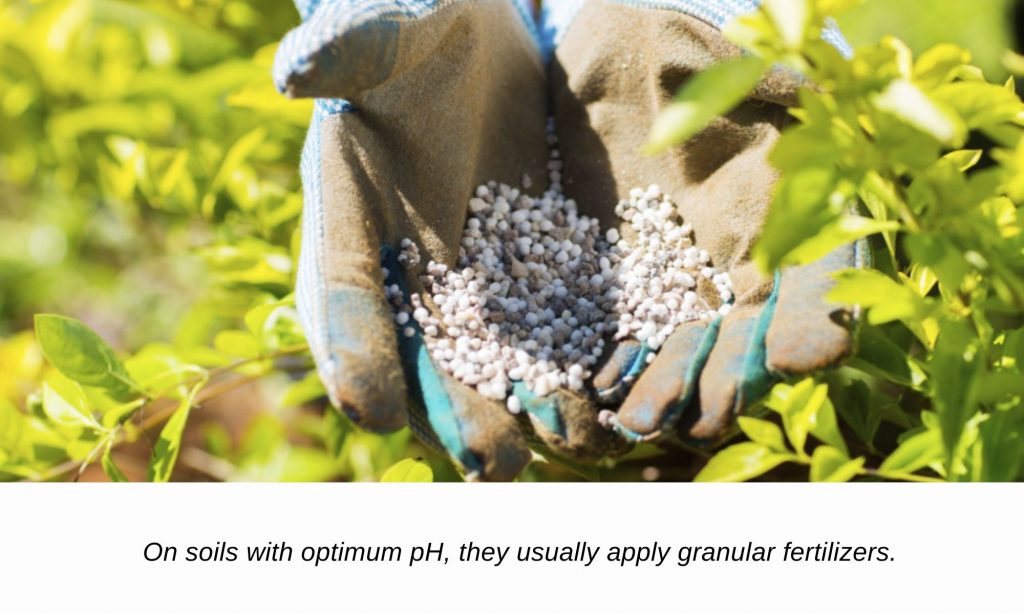Manganese (Mn) is one of the most common chemical elements. It’s a component (active ingredient) of fertilizing compounds and micro fertilizers and is often added to mineral fertilizers. They use the nutrient for seed treatment, foliar dressing, and application to the soil as a pre-sowing fertilizer.
Manganese in nature
Manganese is a metal; in most people’s minds, this means that the substance has a gray, yellow, or white color and glitters characteristically in the light. However, it’s a true chemical chameleon. Although it corresponds to the external description of metal, its compounds are so multicolored that they form a rainbow, depending on the oxidation degree of the element in the substance.
Manganese compounds are very interesting not only in terms of color but also in terms of their properties. Potassium permanganate has an antiseptic effect, Mn2O7 oxide is an explosive substance. What’s more, manganese, although the need for it is extremely small, is one of the essential trace elements needed by living cells.

This element is one of the most abundant in the lithosphere and yet, in nature, it can’t be found in its pure form. The content of manganese in the Earth’s crust is 0.09%. It prevails in soil-forming rocks.
Mn in minerals
Manganese is part of a large number of minerals, mainly of the oxide type. The most common are pyrolusite (MnO2) and psilomelane (a colloidal form of MnO2). These are oxide minerals with a predominance of tetravalent manganese. Braunite, manganite, and black ochre are also common.
Most manganese-containing ores are found as secondary deposits; primary deposits are less common.
Mn in soils
In soils, manganese is found in the form of salts, oxides, hydroxides, and complex ions. Oxides are amorphous compounds, but crystalline varieties are found in some types of soils. Pyrolusite, manganite, and hausmannite are the most stable. In addition, manganese forms a number of different minerals, where it’s usually in oxidation grades II, III, and IV.
In rock-forming silicate minerals, the Mn(II) state is more common.
Under aerobic conditions, the element is characterized by low solubility. In an alkaline environment, solubility decreases due to the formation of hydroxides.

In acidic and neutral soil solutions, manganese hydrophosphate has less solubility than hydroxides. Its formation controls the mobility of this metal in these conditions.
The direction of redox reactions involving Mn depends on the activities of microorganisms involved in the accumulation and oxidation of this element.
Manganese forms compounds with humic substances of soils. Compounds with fulvic acids are characterized by increased migration ability and availability to plants.
The main barriers to the movement of manganese in the soil are alkaline environments, carbonates, and the increased content of humus.
The distribution of manganese in the soil is heterogeneous. It’s concentrated not only in the form of nodules but also in the form of individual admixtures enriched with other elements. It’s characteristic that the noted heterogeneity doesn’t depend on soil type. The highest content is observed in soils developed on basic rocks rich in iron and organic matter. Additionally, soils in arid and semi-arid areas contain a large amount of this element. Manganese accumulates in various horizons, especially in those enriched with iron oxide and hydroxide. But usually, it’s accumulated in the upper soil layer due to its fixation by organic matter.
Role of manganese in plants
Manganese is an essential element for all plants. Its average content in plants is 0.001% or 0.0003 oz. per 2.2 lbs of weight. It’s mainly concentrated in leaves and chloroplasts.
Its participation in photosynthesis was established: after the addition of the nutrient to plants that were deficient in it, the recovery of photosynthesis rate was observed after 20 minutes. Manganese is involved in the system of oxygen release during photosynthesis and in reductive reactions of photosynthesis. It increases the content of sugars, chlorophyll, and its bonds with protein, improves the outflow of sugars, increases the intensity of respiration.

Manganese is a part of hydroxylamine reductase, which reduces hydroxylamine to ammonia, as well as an assimilation enzyme that reduces carbon dioxide during photosynthesis. It’s involved in the activation of many reactions, including the conversion of di- and tricarboxylic acids during respiration. It’s also assumed that the element is a part of the enzyme that synthesizes ascorbic acid.
The element is also involved in the mechanism of influence of indoleacetic acid on cell growth. Its importance as a cofactor of auxin oxidase for enzymatic degradation of indoleacetic acid was shown. Calcium and manganese contribute to the selective absorption of ions from the external environment. With the exclusion of the element from the nutrient medium in plant tissues, there’s an increase in the concentration of the main elements of mineral nutrition, their ratio in the nutrient balance is disturbed. There’s evidence of the effect of manganese on the movement of phosphorus from the aging lower leaves to the upper leaves and reproductive organs. It increases the water retention capacity of tissues, reduces transpiration, and affects the fructification of plants.
Manganese deficiency in plants
Symptoms of manganese deficiency are most often observed in carbonate and acidic calcareous soils. The critical minimum concentration of this element in mature leaves varies from 0.0003 to 0.0008 oz. per 2.2 lbs dry weight.
Under conditions of the nutrient deficiency, the production of photosynthetic oxygen is primarily reduced. At the same time, chlorophyll and leaf dry weight content change insignificantly, but the structure of thylakoid membranes changes notably.
Under severe deficiency, chlorophyll content in leaves decreases significantly, and lipid content in chloroplasts also decreases.
Disruption of the photosynthesis system leads to a sharp decrease in carbohydrate content in the plant, especially in the root part. This is a key factor in slowing down the growth of the root system in case of the nutrient deficiency.
In the case of manganese deficiency, the protein content of plants is almost unchanged, while the content of soluble forms of nitrogen increases.
Visually, symptoms of manganese deficiency in different plant species are somewhat different. For example, dicotyledons have interstitial chlorosis, grasses have greenish-gray spots on the basal leaves (gray spotting), and beets’ leaves turn dark red with affected brown areas.
In case the deficiency is acute, there can be a complete lack of fruiting in plants like cabbage, radish, peas, tomato, and other crops. Manganese helps accelerate the overall development of plants.
Manganese excess in plants
The excess of the nutrient leads to suppression and even death of plants. The toxicity of this element is most pronounced in acidic sod-podzolic soils, especially in case of high humidity, crust formation, and physiologically acidic fertilizers without their neutralization. The mobile forms of aluminum and iron increase the harmfulness of manganese toxicity.
Common symptoms of manganese excess:
Cucumbers:
- Young leaf veins turn yellow, with dark dots of purple color on the back side of the veins;
- Leaf petioles and shoots are covered with the same dots;
- When the excess of the element is intensified, the leaf turns yellow, the veins are dark purple;
- Dark purple spots on fruits.
Tomatoes:
- Growth stops;
- Young leaves become smaller;
- Early leaves show chlorosis. Necrotic spots and brown veins on older leaves.
Inhibition of growth and plant death are common symptoms of manganese toxicity for all plants.
Manganese fertilizers
The best way to restore the manganese equilibrium in the soil is by using the right fertilizers. The main source of the element for fertilizer production is oxide manganese ores of sedimentary origin. They are subdivided, depending on the content of iron and basic substance, into three categories:
- Manganese — 40% Mn and less than 10% iron;
- Ferromanganese — 5-40% of Mn and 10-35% of iron;
- Manganese iron — less than 5 % of Mn.
In oxide ores, Mn compounds are poorly soluble in acids. Therefore, it’s considered most effective to use carbonate Mn ores and industrial wastes for fertilizer production.
The latter must undergo a reduction roasting stage and contain manganese in the form of MnO. These are usually waste products from manganese-ore enterprises, containing 10-18% Mn.
Manganese sulfate and manganese oxide are generally used to create various forms of fertilizer. The same forms can also be used on their own.
Manganese sulfate (MnSO4)
Fine crystalline, white or gray, dry, anhydrous salt with 21-24% Mn content, which is well soluble in water. It’s used for pre-sowing dry powdering of seeds and for foliar feeding. For seed treatment, the salt gets well dried, crushed, and mixed with talc in different ratios (1.7-3.5 oz. of salt and 7-14 oz. of talc per 2.2 lbs of seeds). Foliar feeding is carried out by 0.05-0.3% solution of this salt.
Manganese superphosphate
Obtained by adding 10-15% Mn concentrate, which contains 35-40% of the nutrient, to simple superphosphate before granulation. The fertilizer has dark gray granules, contains 20 ± 1% P2O5 and about 1-2% Mn.
Manganese-containing powder
A mechanical mixture of finely ground dry manganese sulfate (18-22%) and technical talc. It’s used for pre-sowing seed coating: for grain crops, corn, sunflower.
Manganese nitrophoska
In addition to nitrogen, phosphorus and potassium contains about 0.9% of Mn, which is well assimilated by plants. This fertilizer is applied as a basic fertilizer during sowing and for top dressing.
Fertilizer application specifics
- On soils with optimum pH (5.0-6.5), they usually apply granular fertilizers. This creates a sufficient background for most cereals and industrial crops. In this case, it’s recommended to carry out foliar feeding with chelated fertilizers during critical periods: when the ground is cold, when there’s drought and when the crop requires intensive nitrogen nutrition.
- In critical phases, leaf diagnosis is required. If diagnosis results reveal a lack of the nutrient or if there are visual signs of deficiency, soil fertilizers won’t be able to solve the problem. In this case, the only true solution is foliar feeding.
- The worst fertilizer is manganese chloride, which contains chlorine and therefore also causes poisoning of plants, especially vegetables. Manganese sulfate can be used with the same effectiveness, but with a lower risk of plant poisoning.
Chelated manganese fertilizers are of the highest quality. They can be used for foliar application and by drip irrigation.

There are two types of chelates that deserve special attention: EDTA compounds and lignosulfonates.
Both groups are well compatible with other fertilizers and pesticides. The difference is that EDTA chelates are cheaper, but toxic to the plant when over-concentrated and less able to penetrate the leaves.
Lignosulfonate-based chelates penetrate the leaves better and have moderate anti-stress effects. Lignosulfonate is of plant origin and therefore does not cause phytotoxicity.
Conclusion
The best way to make sure your plants get as much manganese as they need is to use manganese-containing fertilizers. The application of fertilizers contributes to higher yields. But in addition to increasing yields, the use of Mn-containing fertilizers has a beneficial effect on the quality of agricultural products. The content of protein, sugars, crude protein, fats, gluten, and vitamins increases.


